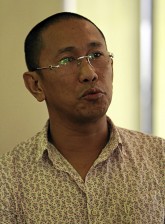
The prosecution is set to present at least four more Maguindanao officials next week, including Governor Esmael “Toto” Mangudadatu, whose wife Genelyn and other relatives were among the victims in the massacre being blamed on the Ampatuan clan. INQUIRER FILE PHOTO
Royal blue, midnight blue or GSM blue?
Coloring a map of Maguindanao offered a rare light moment in the normally serious trial of the massacre that claimed 57 lives in the province as lawyers debated marker shades.
Abdulrakiman Asim, officer in charge of the Maguindanao engineering office, took the witness stand for the prosecution yesterday.
He presented to the court a huge map of Maguindanao and adjacent provinces, the map having been drawn under his supervision.
The prosecution then attempted to mark the boundaries of Maguindanao’s towns using different colored pens.
The prosecution wanted to corroborate through Asim’s testimony the previous testimonies of other witnesses on the checkpoints that had stopped the vehicular convoy ferrying the victims on that fateful day of Nov. 23, 2009.
But the lawyers had run out of colors.
The usually stern Judge Jocelyn Solis-Reyes rushed off to her chambers and returned wielding a hot-pink marker.
Later, the lawyers could not decide what shade of blue they had used so this could be entered in the court records.
One lawyer said it was royal blue while assistant state prosecutor Amor Robles thought it was a darker hue.
Someone then suggested it was midnight blue, to which defense lawyer Andres Manuel replied that it was “GSM blue,” referring to the shade of blue on the label of popular gin brand Ginebra San Miguel, a Filipino favorite.
After some discussion, the opposing panels finally settled on plain old “blue” for the record.
The prosecution is set to present at least four more Maguindanao officials next week, including Governor Esmael “Toto” Mangudadatu, whose wife Genelyn and other relatives were among the victims in the massacre being blamed on the Ampatuan clan.